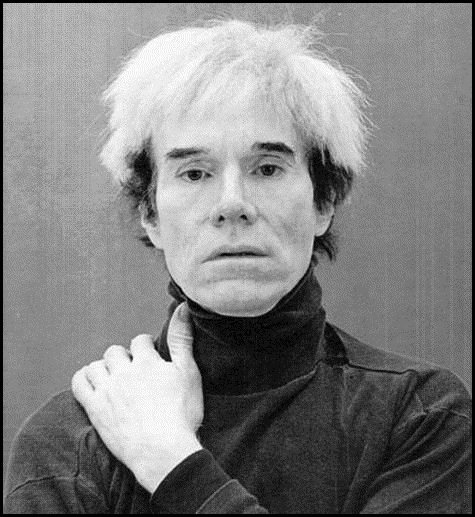And the Can that Sold the World
Gary Indiana
(Basic Books)

When Hugh was done with it, he cast about for another political figure to write about, and came up with Herbert Hoover. He began his research, delved into Hoover's history and quirks and personality for a few months ... and then found that his new book was going nowhere. He simply couldn't get it together. "He was too dull. He was so dull it put me to sleep just reading about him," he wrote. "I had to give it up." Rather than write a soporific book, he decided to write an autobiography. A fine one, too.
Robert Indiana might have thought about doing the same. Bailing out, that is. Andy Warhol, despite all the grasshoppers jumping out of his turf, was, under it all, a profound dullard. He busied himself creating a character called "Andy Warhol" and ended up by running this fictional creature into the ground.
To his few "friends," he might have been a talkaholic, "you only had to hear him on the phone to realize he was a champion blabbermouth," says Indiana. But the writer then tells of Warhol's last days, where he would come into a crowded room, stare fixedly at the people gathered to observe him ... then disappear, saying nothing. It was "artistic silence" and it was another part of the drama that he pretended was Andy Warhol.
Here we have a biography where the writer seems to be eternally irked by his subject. This is all despite Indiana's insistence that Warhol did something important. Namely, he took a common, inane household object --- a can of soup --- and, on July 9, 1962, through the aegis of the Ferus Galleries in Los Angeles, made it into art. Or better, turned it into a "portrait." And how did his painting get so famous so fast? Warhol "took a photographer to the supermarket, and got his picture taken signing the real thing."
This is the crucial difference. You and I can paint a can of soup, then sign the original in front of a photographer ... but then we would have to somehow do what Warhol did so well. He inveigled the Associated Press to make thousands of copies; that is, wire his picture "around the world."
Indiana thinks that the soup can paintings were "visionary."
- They were works of obdurate stupidity radiating the aptness of genius. They have never lost their iconic punch ... Warhol was a protean maker of meaningful images remarkable for their apparent meaningless.
But for those of us who see Warhol as nothing but a show-off, "protean" and "remarkable" are not exactly the words we would choose.
Thus Warhol is less interesting for its critical statements and more interesting for the occasional peeks into the artist's life. That he grew up poor in Pittsburgh, probably ate Campell's tomato soup every day for twenty years (and hated it); that through his mother's doggedness, he got a degree in graphic arts from the Carnegie-Mellon Institute; that he could be astoundingly pettish: if you angered him, he would cut you off without a word, never talk to you again.
He was an important, successful graphic designer in New York in the 50s, where his specialty was the representation of merchandise. It was infinitely reproducible art, was seen by the world in magazines like Vanity Fair, Harper's Bazaar, Glamour, Vogue, McCalls. "His best known advertising work was done for I. Miller Shoes, whose ads appeared weekly between 1955 and 1957 in the Sunday New York Times," we are told.
- Warhol's headiest success as an illustrator was in his endlessly inventive, often boldly exaggerated designs of ladies' shoes.
In other words, he was a shoe man, and like shoes, his stuff was reproduced an infinite number of times (this was when the Times was selling a million and a half copies every Sunday).
Warhol was a factory man, which is, obviously, why he named his production studio "The Factory." He set out to bury art through overdose, and one of his best quotes was "I want to be a factory." Marilyn Monroe got reproduced thirty-six times, then, after that, some thirty-six thousand more. Mao and Jackie the same. Warhol wasn't so much an artist as a production supervisor. His greatest virtue was that he never hid the fact that he was playing a game ... at least until one of his crowd of followers, Valeria Solanas, damn near killed him. After that, he retired a walled community of himself and his less virulent friends.
No matter how hard Indiana strives to make us believe that one show at the Ferus Galleries changed the face of America art, I suspect the only thing it changed was the incredulity of the masses ... who viewed a large silkscreen of something they saw every day stacked up in the local Piggly-Wiggly and then rightly wondered, as we all should, why such could sell for $11,000,000.